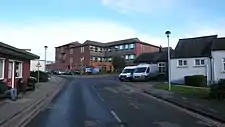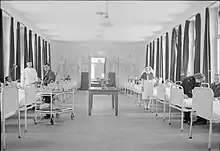RAF Hospital Northallerton
RAF Hospital Northallerton, was a Second World War era military hospital, in Northallerton, Yorkshire, England. The Friarage Hospital now stands where the former hospital once stood.
| RAF Hospital Northallerton | |
|---|---|
| Royal Air Force | |
 Friarage Hospital site | |
| Geography | |
| Location | Northallerton, North Riding of Yorkshire, England |
| Coordinates | 54.342°N 1.429°W |
| Organisation | |
| Care system | Military |
| Funding | Government hospital |
| Services | |
| Beds | 450 (July 1944) |
| History | |
| Construction started | 1938 |
| Opened | January 1943 |
| Closed | November 1947 |
| Links | |
| Lists | Hospitals in England |
The site was a once a temporary medical care centre, set up in 1938 in case of bombing casualties in the area, including Middlesbrough and Stockton-on-Tees. The Royal Air Force (RAF) took over the hospital in 1943 and relinquished it in 1947. The hospital catered specifically for RAF and Royal Canadian Air Force (RCAF) personnel.
History
The hospital was sited on the old Northallerton Workhouse next to Sun Beck. Before that, the site had been occupied by a Carmelite friary, from where the modern day hospital would derive its name (The Friarage).[1]
In the late 1930s, eight wooden huts were assembled on the site. These were prepared for casualties of expected bombing runs over areas near ports and industry on the River Tees, though initially, the hospital housed evacuated wounded service personnel from Dunkirk.[2]
The hospital site was turned over to the Royal Air Force in January 1943,[3][note 1] with a remit for healthcare for those injured during air operations from the many airfields of No. 6 Group which were scattered around North Yorkshire.[5][note 2] Previous to this, air force casualties were sent to the Army hospital at Catterick, or other RAF hospitals, but no Royal Air Force medical facility existed in the north-eastern area, which prompted the takeover of the facilities in Northallerton.[8]
The hospital needed some work before it could be transferred from civilian to service control. New ambulance bays needed to be constructed and more accommodation blocks were required to house 200 staff, besides the initial 200 beds for injured personnel.[9] An acute shortage of fresh water was a problem as the hospital developed beyond the means of its intended size. At one point in 1943, baths were limited to one-a-week for males and two-a-week for females, but only in 5 inches (130 mm) of water. Eventually a new pipeline was laid from nearby Kirby Sigston in October 1943.[10] One of the squadron leaders who worked at the hospital, developed a Mobile Surgical Unit (MSU). This was an ambulance (a Humber Utility Van), with an anaesthetist, a surgeon, a resuscitation officer, a theatre sister and an operating room assistant. The MSU made at least 25 operational runs to aircraft crashes across North Yorkshire, and the timely efforts saved many lives.[11] The MSU also performed surgery at various airfield station sick quarters when it was considered inadvisable to move the patient to the hospital.[12] As the hospital catered largely for personnel from No. 6 Group, (which consisted of 15 RCAF squadrons),[13] it also had a complement of RCAF nursing staff of four medical officers and ten nurses.[14][note 3]
At the outbreak of the Second World War, the Royal Canadian Air Force did not possess a medical branch of its own, with that function being undertaken by the Royal Canadian Army Medical Corps. In 1940, a training regime was implemented and by 1943, the RCAF medical branch had nurses at Warrington, Bournemouth, East Grinstead and Northallerton.[16] The large number of RCAF squadrons allocated to bases in North Yorkshire (15 squadrons in all), meant that injured RCAF personnel being admitted to the RAF Hospital in Northallerton, numbered 155 in one month alone in 1944. Serious consideration was given by the Canadian military to the hospital becoming a solely Canadian affair, but the plan was eventually dropped,[17] especially given the resistance by the then director of RAF Medical Services (Harold Whittingham), who did not want medical services divided.[18]
By July 1944, 450 beds were available, but emergency protocols existed to push this number to 525 if necessary.[19] By 1945, the hospital had 390 beds and was being recommended for return to civilian use.[20] In the last year of the war, ENSA members (Robert Donat, Bernard Miles) visited the hospital to entertain the patients, and the hospital chapel was formally opened.[21] Between the peace of 1945, and November 1947, the hospital took on successive convoys of invalided patients and casualties returning from the theatre of war. RAF Hospital Northallerton had at least 44 'convoys' and dealt with 856 returning soldiers, sailors and airmen.[22]
In November 1947, the hospital was returned to civilian use,[23] and in 1948, was renamed the Friarage, in honour of the friary that had once existed on the site.[24] Many of the wooden huts at the hospital, which were constructed from Canadian Oregon and Cedar Pine, remained on site until 1999, when they were finally demolished. With the downgrading of the Duchess of Kent Military Hospital at Catterick Garrison, service personnel returned to the Friarage site as part of the MHDU (Ministry of Defence Hospital Unit).[25]
Commanding officers
Notes
- A Ministry of Health report from 1945 states the hospital was commandeered on 31 December 1942.[4]
- No. 6 Group operated from RAF stations at Croft, Dalton, Dishforth, East Moor, Leeming, Linton-on-Ouse, Middleton St George, Skipton-on-Swale, Tholthorpe, Topcliffe, Wombleton.[6] Non-aircrew military personnel were also treated at Northallerton.[7]
- Nicholson suggests that in 1944, this breakdown was three medical officers, one matron, and six nurses.[15]
References
- Riordan 2002, p. 46.
- Chapman, Hannah (26 February 2019). "Fighting for the Friarage: A community which loves its hospital". The Northern Echo. Retrieved 29 August 2021.
- "RAF Hospital Northallerton (UK) formed January 1943, disbanded November 1947". discovery.nationalarchives.gov.uk. Retrieved 29 August 2021.
- Lett, Hugh; Quine, A E (1945). Hospital Survey. London: HMSO. p. 78. OCLC 40203710.
- Riordan 2002, p. 311.
- Jacobs, Peter (2017). Bomber Command Airfields of Yorkshire. Barnsley: Pen and Sword. p. iv. ISBN 978-1783463312.
- "ROYAL AIR FORCE (DISCHARGED AIRMAN) (Hansard, 17 September 1948)". api.parliament.uk. Retrieved 31 August 2021.
- Rexford-Welch 1954, p. 229.
- Rexford-Welch 1954, pp. 229–230.
- Riordan 2006, p. 24.
- Riordan 2002, pp. 312–313.
- Rexford-Welch 1954, p. 231.
- Ward, Chris (2009). 6 Group Bomber Command : an operational record. Barnsley: Pen & Sword Aviation. p. vii. ISBN 978-1-84884-155-0.
- Rexford-Welch 1954, pp. 231–232.
- Nicholson, G. W. L. (1975). Canada's nursing sisters. Toronto: S. Stevens. p. 193. ISBN 0888665679.
- March, William (2012). "RCAF Nursing Sisters". The Royal Canadian Air Force Journal. Trenton: Canadian Forces Aerospace Warfare Centre. 1 (1): 43–45. ISSN 1927-7601. OCLC 780180329.
- Feasby, William R (1956). Official history of the Canadian medical services, 1939-1945. Ottawa: Queen's Printer. p. 361. OCLC 41730852.
- Riordan 2006, p. 23.
- Rexford-Welch 1954, p. 230.
- Lett, Hugh; Quine, A E (1945). Hospital Survey. London: HMSO. pp. 78–81. OCLC 40203710.
- Riordan 2002, p. 313.
- Riordan 2006, p. 27.
- Rexford-Welch 1954, p. 232.
- "History of the Friarage | South Tees Hospitals NHS Foundation Trust". www.southtees.nhs.uk. Retrieved 30 August 2021.
- Engebrecht, Gavin (19 August 1999). "Wartime staff honoured by hospital". The Northern Echo. p. 6. ISSN 2043-0442.
- Jobling, C. D. (16 April 1960). "Obituary". BMJ. 1 (5180): 1,211. doi:10.1136/bmj.1.5180.1211. S2CID 220172194.
Sources
- Rexford-Welch, Samuel Cuthbert (1954). Royal Air Force Medical Services. London: HMSO. OCLC 1072173557.
- Riordan, Michael (2002). The history of Northallerton : from the earliest times to the year 2000. Pickering: Blackthorn Press. ISBN 0-9540535-0-8.
- Riordan, Michael (2006). The Friarage Story (2 ed.). Northallerton: Friends of The Friarage Hospital. OCLC 258043247.

